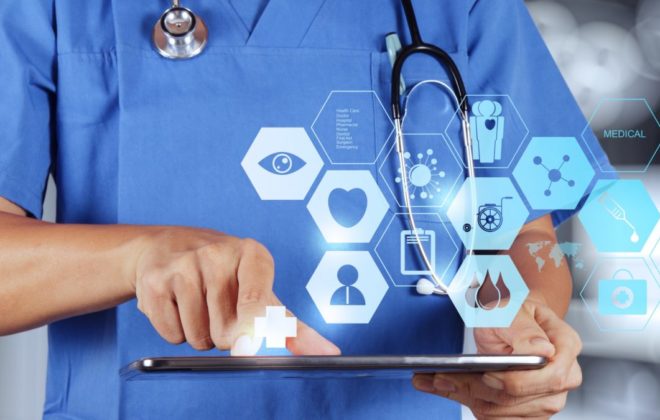IoT is Set to Disrupt the Healthcare Service Delivery Model
The Internet of Things (IoT) is already revolutionizing healthcare. In simple terms, the IoT for healthcare comprises devices and applications that are able to connect to healthcare IT systems through computer networks. These devices include wireless sensors, which gather and can send information to caregivers, and this information is stored on cloud platforms for further analysis.
With newer technologies and tools, the IoT is bringing about a positive transformation in the healthcare industry by offering new tools to connect devices and people. It offers an integrated healthcare solution with improved processes, patient care, better treatment outcomes, and reduced treatment costs.
This blog attempts to throw some light on the reasons why the IoT is all set to transform the healthcare industry.
The market for the IoT in healthcare is growing steadily, with numerous practical applications ranging from remote monitoring to improving security.
The Business Insider forecasts that the installed base of healthcare IoT devices, excluding wearable devices, will grow to approximately 646 million in 2020.
Remote Monitoring of Patients
IoT enabled devices in the form of wearable sensors are used to remotely gather information of elderly patients, patients with chronic health conditions, and those requiring constant supervision. Smart medication dispensers installed at home can alert doctors when patients do not take their medicine correctly or on time. It enables the doctors to know about patients’ health status and respond to them in real time. This also saves patients the trouble of having to travel to a hospital or clinic for their regular checkups. Patients, especially those residing in remote locations, can get good quality health care at home.
Maintain Medical Inventory
The IoT finds its usefulness in tracking and managing hospital supplies and medicine. Some hospitals are using RFID tags that are placed on medical equipment and supplies so that the hospital staff gets regular updates about the quantities they have in stock. Many hospitals have installed wireless sensors in refrigerators, freezers, and laboratories to ensure that blood samples and important vaccines and other medicines are stored at the proper temperatures.
A good example is that of a Smart Fridge that lets clinicians protect and store vaccines and distribute it to needy patients in remote locations where the power supply is unstable. This smart fridge includes remote monitoring devices, which ensure that the vaccines are stored at the right temperature and dispensed correctly to save time and enhance patient care.
Improve Security
Hospitals are using smart devices and the IoT to enhance the safety of their patients, and improve security and operational efficiency.
For instance, to step-up infant protection, some hospitals attach wristbands on their new-born babies. These wristbands are smart devices that are connected to a wireless network allowing the babies to be easily tracked and located at any time. If an infant is being carried towards the exit door without being signed out, an alarm is raised and the exit doors are locked.
Nurses in the intensive care unit receive critical alerts on their cell phones about their patients’ medical conditions, such as temperature, heart rate, blood pressure, allowing them to attend to their patients’ quickly. This saves time for the staff that has to otherwise make frequent rounds in the wards to collect this information manually.
Improve Patient Care
Many hospitals and nursing homes use infusion pumps to deliver fluids, such as nutrients and medicines in controlled amounts to their patients’ body. Big hospitals are now using IoT to automatically dispense and change medications in the infusion pumps instead of having to visit each patient and dispensing the medication manually.
In the cardiology unit of hospitals, cardiologists require ECG readings and blood pressure readings to monitor their patients’ health. By using an IoT solution built on a cloud platform, doctors are able to get all of the patients’ vital data on summative dashboards, which help them give timely care to the patients, and at the same time, lower healthcare costs and provide quality care in remote and underdeveloped regions.
Maintaining Medical Equipment
IoT is also used to remotely monitor and diagnose medical equipment. Medical equipment manufacturers are using predictive maintenance to manage the health of critical and expensive medical equipment, and thus, significantly improving their uptime.
Benefits
By using smart device technology and IoT, healthcare organizations gain several benefits, some of which include the following:
Reduced costs: With smart devices that are connected to the healthcare network, patients are monitored on a real-time basis, thus enabling doctors to reduce their visits. Also, patients can get their treatment advice at home thereby reducing unnecessary costly visits to the doctor.
Improved management of diseases: When patients are monitored on a real-time basis, healthcare givers can offer treatment that is evidence-based; hence diseases can be treated before they get out of hand.
Reduced Errors: An accurate collection of data, automated workflows, and data-driven decisions result in reduced errors.
Faster time to market for drugs: Clinical trials leverage IoT technology to simplify the process of gathering patient data, thus improving the efficiency and cost-effectiveness of these trials resulting in reduced time to bring new drugs to market.
Conclusion
It is beyond doubt that the Internet of Things has gained immense popularity in the healthcare industry as it redefines how people and devices connect and interact with each other. The IoT constantly offers newer tools and smart connected solutions designed to improve our health, reduce costs, and improve treatment outcomes. Healthcare providers, manufacturers of medical equipment, patients and consumers need to keep their minds open to leverage this revolution in healthcare that IoT is bringing for us.




